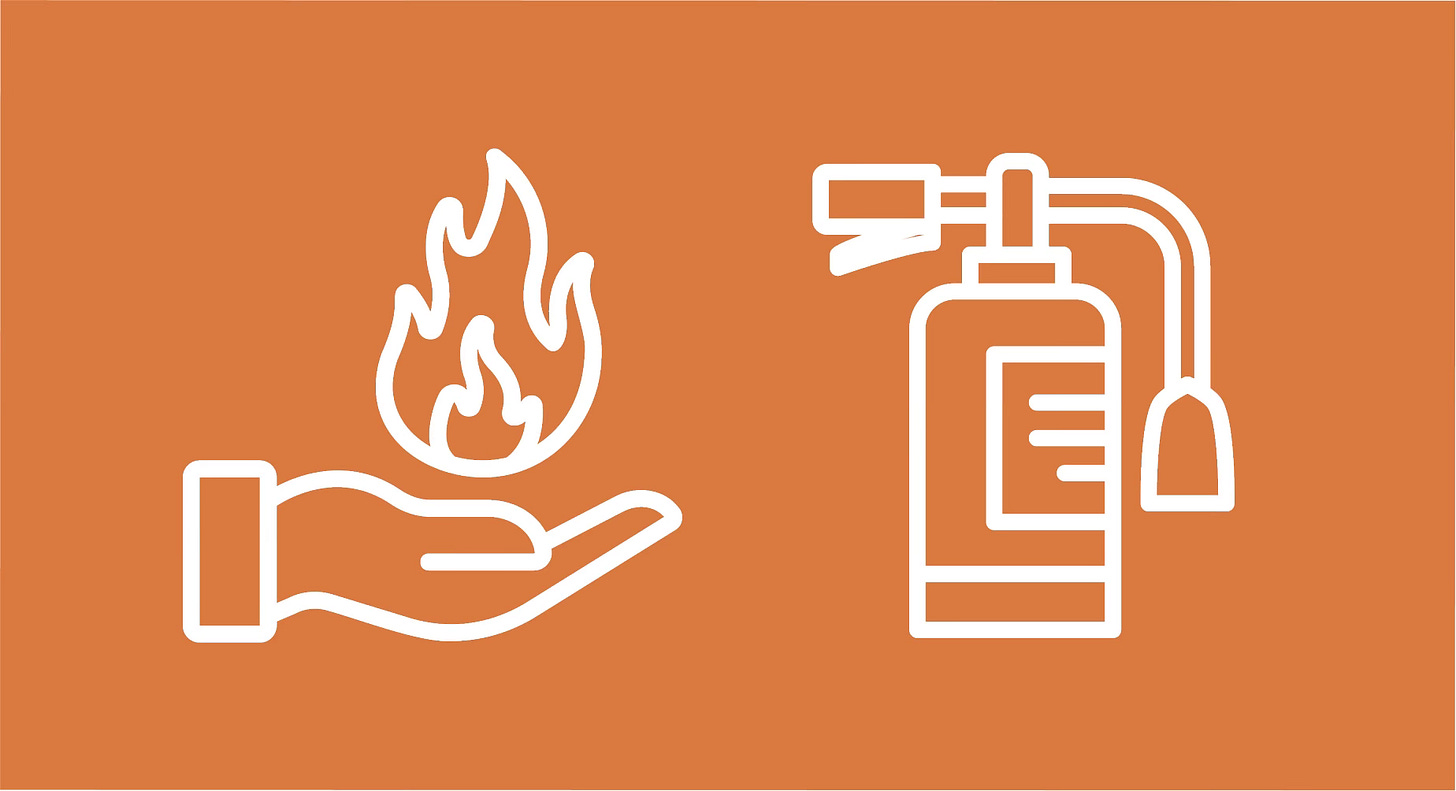Forensic UX
Or, how to de-f*ck any design project
🚨 Heads up - This post comes with templates. You can either buy them on Gumroad, or join this Substack as a paid subscriber to get all templates free plus 170+ article archive.
I have worked in several roles where I have ended up becoming the UX Fire Department.
Sounds dreadful but I have to admit, there were times where I kind of enjoyed it.
Because often when there’s enough risk (i.e. things on fire), stakeholders are more likely to allow you do things like.. Research. Testing. Evidence-based, User-Centred Design.
You know, that kind of thing.
Running a UX Fire Department left me with the kinds of skills and experiences which come from repeatedly de-f’ing other peoples’ design projects.
And over the years I’ve taught it to others.
I called this skill set… Forensic UX design.
What is Forensic UX?
Firstly, I might have made this term up.
Secondly, therefore, I’ll define it.
Forensic UX is the process of digging through the absolute mountain of half-finished, half-thought-through, possibly completely fake deliverables that other people have created in an attempt to ‘do the UX’ of a digital product or service.
Usually while thinking “this can’t be so hard” or “UX is just common sense” or any other of the phrases that make me want to napalm large swathes of agency land.
Part archaeologist, part misanthrope, part bringer of hope, the role of the forensic UXer is to work out what on earth people thought they were doing; including what they were asked to do, what they did, where it went wrong, where the massive gaping gaps are in their thinking or actions and finally.. get it all back on track.
And all of this while putting out whatever stakeholder, reputational or financial fires are happening in the background.
.
What does a Forensic UX project look like?
In the beginning, a Forensic UX project looks like an absolute car crash. You are invited to a meeting where everyone looks very nervous, while pretending it’s all kinds of awesome.
Usually you are asked for ‘a bit of help’ and within minutes you realise that the entire project is a World War II aeroplane, on fire, moving in ever decreasing circles towards the ground.
Here are the signals:
A project is behind schedule. By A LOT
Someone has produced a lot of deliverables that aren’t helping or understood
The project is stuck
Or they launched something and it failed very very very badly.
No one seems to be able to explain why anything has happened
Someone senior somewhere is VERY unhappy
No one knows what anyone should be doing next.
Examples of fires
Here are some examples of just a few real life fires I’ve been asked to put out:
The one where they pitched for and won a project to produce ‘a new brand and 10 web page templates’ but it was actually a Multiplatform global digital re-platforming
The one where they’d promised to design a new sign up form, but it was actually a massive multi-product single-sign-on migration
The one where they’d sold in a web3 digital experience for a training program when a powerpoint deck would have been more usable for the trainers
The one where they’d designed 10 posters when the client actually needed physical way finding, human factors, ergonomics skills to design a physical building interior and digital journey integration
The one where the team spent 10 months starting from UI and gradually moving backwards through wireframes into IA as the client gradually pulled the project apart
The one where they spent $1000s on contractors doing UI over and over for 12 months because no one had bothered to gather… requirements. 🤦♂️
What do they want me to do about it?
Your job now is to take the project from ‘on fire’ to ‘back on track’ - i.e. once more following some kind of user-centred design process and with stakeholders mostly pacified.
Note: the sad news that you have to be prepared for is that the minute it looks like it’s going to be ok, all those traditional ‘we don’t care about users, just make me a shiny’ attitudes will come pouring back in and you will probably be ousted from the project without thanks, and final delivery handed back to whoever just went and made a load of UI at the beginning anyway.
Just saying.
How can I fix this mess?
Essentially you need to rewind the whole project without anyone who paid for it in the first place catching wind, as they will most likely be a bit upset about it.
Think of it as reverse-UCD, or pre-UCD or… Forensic UCD.
Yes it’s a bit scary
Taking on a project that is manifestly on fire is a daunting task, even when you’ve done it 100s of times. (Again, thank you Marketing agencies)
As with any large scale UX or Service Design project, it’s about designing a process, executing a process, and trusting a process until the world makes sense once more.
Here’s how to get through it alive
Here’s the step-by-step approach to sorting out other peoples’ mess, while looking like you know what you’re doing.
Keep reading with a 7-day free trial
Subscribe to It Depends... to keep reading this post and get 7 days of free access to the full post archives.


